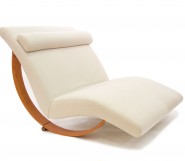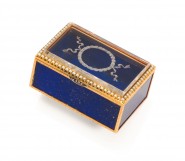Lot #23 - Philip Clairmont
-
Auction House:Mossgreen-Webb's
-
Sale Name:Important Paintings & Contemporary Art
-
Sale Date:29 Nov 2016 ~ 6.30pm (NZ time)
-
Lot #:23
-
Lot Description:Philip Clairmont
Carrington Chair
oil on jute canvas
1360mm x 890mm
signed with initials PC (indistinctly) in brushpoint lower left -
Provenance:Purchased by the present owner from Webb 's, July 1997.
-
References:NZ on Screen, Profiles, Philip Clairmont, television, 1981.
-
Notes:Although he was to die very young by his own hand, Philip Clairmont (1949-1984) had already attained prominence as an artist in his twenties, with works acquired for important collections. One bought by the National Gallery in 1978, The Scarred Couch , 'immediately became one of the signature works of the collection', according to Ron Brownson, who describes it as a work of 'extraordinary drama, ; almost erotic in its material sensuousness' (in McAloon, Art at Te Papa , 2009, 321). It was unsettling neo-expressionist images like this that made Clairmont's name, and Carrington Chair is no exception. It seems a paradoxical approach for the subject of a chair, usually associated with quiet rest and inactivity. Clairmont's chair is far from inert. It is enlivened in part because it is presented from the rear at an odd angle, so that it does not seem symmetrical, its legs splayed and without any firm foundation to stand on, and its backrest skewed. But above all, it is the chair's colour that makes it idiosyncratically animated. Although darker than the rest of the painting, the deeper tones are interrupted by passages of intense colour - primary reds, yellows, blues - that create an unstable almost hallucinatory image, heightened in the artificial light by which Clairmont invariably worked. Dominated by radiant golden tones and even more vivid than the chair itself, the background is a swirl of abstract forms - arcs, spikes and chevrons - which jostle with each other in vibrant discord, so that the whole picture plane is activated, and the eye of the viewer is constantly on the move. A painting of a chair inevitably reminds us of Van Gogh's famous painting, Vincent's Chair of 1888, although this one is closer to his less well-known companion piece, Gauguin's Chair , in both the form of the chair and the fact that it is a night piece. Many paintings have paid homage to these works, coincidentally My Chair (1956) by Rudolf Gopas, possibly the most influential of Clairmont's teachers when he attended the Ilam School of Art in Christchurch from 1967 to 1970, where Gopas introduced his students to Expressionism. Van Gogh's chairs were clearly meant as surrogate portraits of the artist and Gauguin and their stormy relationship at Arles, and they afford insight into how we might read Clairmont's paintings of furniture, which are no domestic genre studies - most especially perhaps this chair, named for the Carrington Psychiatric Hospital that witnessed many episodes of Clairmont's addictions and disturbed mental state. In an interview for Screen NZ Profiles in 1981 (where Carrington Chair can be seen in studio shots), Clairmont spoke of how the specific objects he painted, however battered and old, had acquired importance - a certain 'mana'. His many chair studies endow them with a corresponding vitality, almost a personality. It is revealing that, in speaking of another painting that he was busy with in 1981, a window study, Clairmont said it provided 'an internal view - of the inside of my head perhaps'. It suggests that Carrington Chair is more than a portrayal of a chair; it is in many ways an autobiographical portrait of the artist himself. Elizabeth Rankin
-
Estimate:NZ$50,000 - 70,000
-
Realised Price:
-
Category:Art
This Sale has been held and this item is no longer available. Details are provided for information purposes only.










